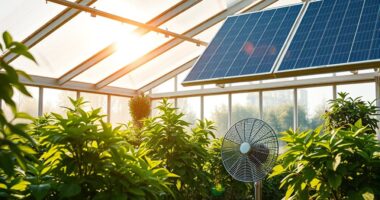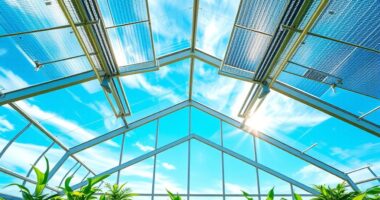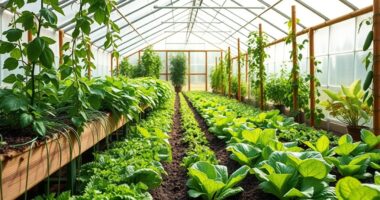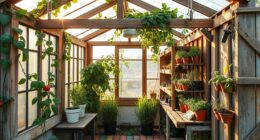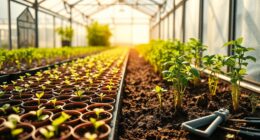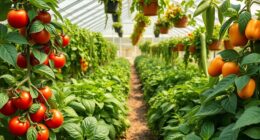When constructing an eco-friendly greenhouse, consider using reclaimed or recycled wood for its durability and rustic charm. Recycled plastic panels offer insulation and lightweight handling, while bamboo frameworks provide a renewable and strong option. Don’t overlook glass alternatives like polycarbonate for impact resistance. Engineered lumber enhances structural integrity and reduces carbon emissions. These materials not only benefit the environment but also improve your greenhouse’s efficiency. Stay tuned for more insights on sustainable construction options.
Key Takeaways
- Reclaimed or recycled wood offers durability and rustic charm while protecting forests and reducing demand for new lumber.
- Recycled plastic panels provide lightweight handling, excellent insulation, and UV resistance, making them cost-effective for eco-friendly gardening.
- Bamboo frameworks are highly renewable, strong, and absorb CO2, making them an effective choice for sustainable construction.
- Engineered lumber, such as cross-laminated timber, combines structural integrity with energy-efficient production, reducing carbon emissions throughout its lifecycle.
- Glass alternatives like polycarbonate panels ensure excellent light transmission and impact resistance while being more sustainable than traditional glass options.
Reclaimed or Recycled Wood
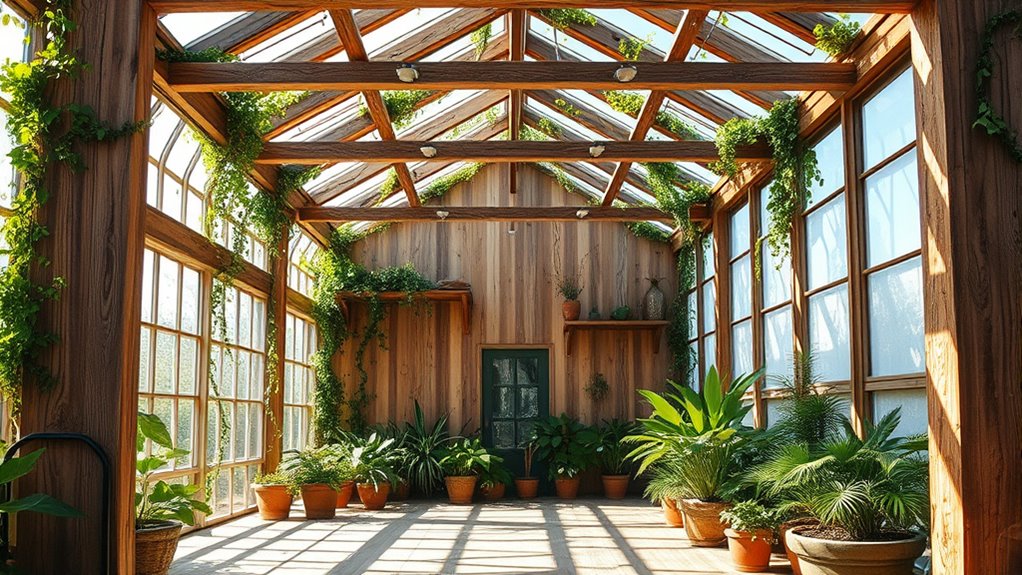
When you choose reclaimed or recycled wood for your greenhouse, you’re not just making an eco-friendly choice; you’re also embracing a unique aesthetic. This wood adds rustic charm, setting your greenhouse apart.
Plus, using reclaimed wood reduces the demand for new lumber, helping to protect our forests and lessen environmental impact. It can be more cost-effective, especially if you source it from salvage yards or community donations.
Using reclaimed wood not only protects our forests but can also be a budget-friendly option when sourced wisely.
You’ll find that reclaimed wood is often sturdier, coming from older trees, which means it’s more durable and resistant to decay.
Ensure you check for structural integrity and treat the wood for moisture resistance to maximize its lifespan, creating a beautiful and sustainable greenhouse that reflects your values. Additionally, consider the importance of local building codes when planning your construction to ensure compliance and sustainability.
Recycled Plastic Panels

Recycled plastic panels offer an innovative solution for sustainable greenhouse construction, combining durability with environmental responsibility. Made from post-consumer recycled plastics, these panels not only reduce waste but also provide excellent insulation and lightweight handling, making them ideal for various greenhouse designs.
They’re often more affordable than traditional materials, giving you a cost-effective option for your eco-friendly gardening projects. With types like polycarbonate and HDPE, you’ll benefit from UV resistance and long-lasting performance.
Installation is straightforward, allowing you to manage the process easily, while regular maintenance ensures optimal light transmission. By choosing recycled plastic panels, you contribute to a greener environment while enjoying the advantages of modern greenhouse technology.
Glass Alternatives
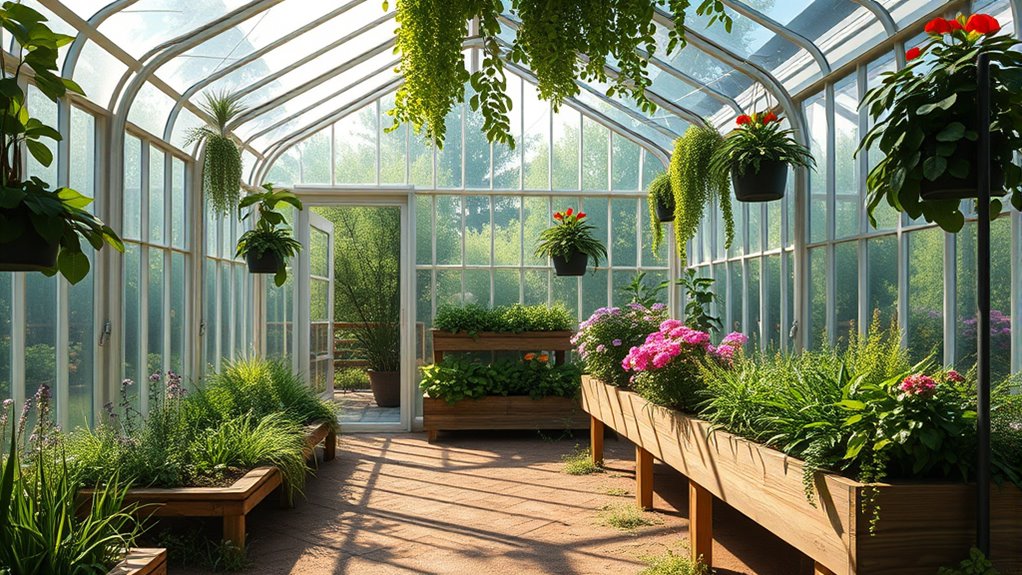
If you’re exploring sustainable options for greenhouse materials, glass alternatives present a compelling choice.
Polycarbonate panels are a top pick, offering excellent impact resistance and light transmission, lasting 10-15 years.
Polycarbonate panels stand out for their durability, providing exceptional light transmission and impact resistance for 10-15 years.
Fiberglass panels, made from recycled glass and resin, also provide good insulation and light diffusion, with a similar lifespan.
Acrylic sheets are cheaper but less recommended due to their tendency to crack under pressure.
While HIPS sheets are inexpensive, they’re not suitable for greenhouses because of brittleness.
Biodegradable plastic panels are eco-friendly and made from plant materials but have a short lifespan of 2-4 years.
Bamboo Frameworks
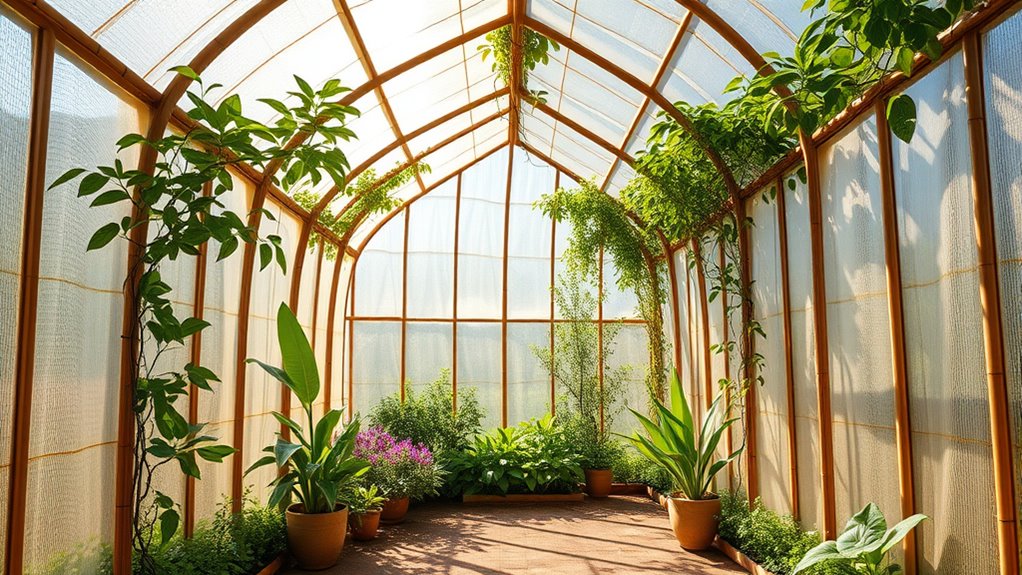
As you consider sustainable options for your greenhouse, bamboo frameworks stand out for their eco-friendly characteristics and impressive structural properties.
Bamboo’s rapid growth—up to three feet per day—makes it a highly renewable resource, and it absorbs more CO2 than many plants, serving as an effective carbon sink.
Its strength and durability make bamboo ideal for framing and supporting structures, providing significant compressive and bending strength.
Cost-effectiveness is another advantage, especially in regions where bamboo is locally sourced.
Additionally, bamboo’s versatility allows it to be used for various components like trellises and structural beams.
With proper treatment for moisture resistance, bamboo can last up to ten years, making it a smart choice for sustainable greenhouse construction.
Engineered Lumber
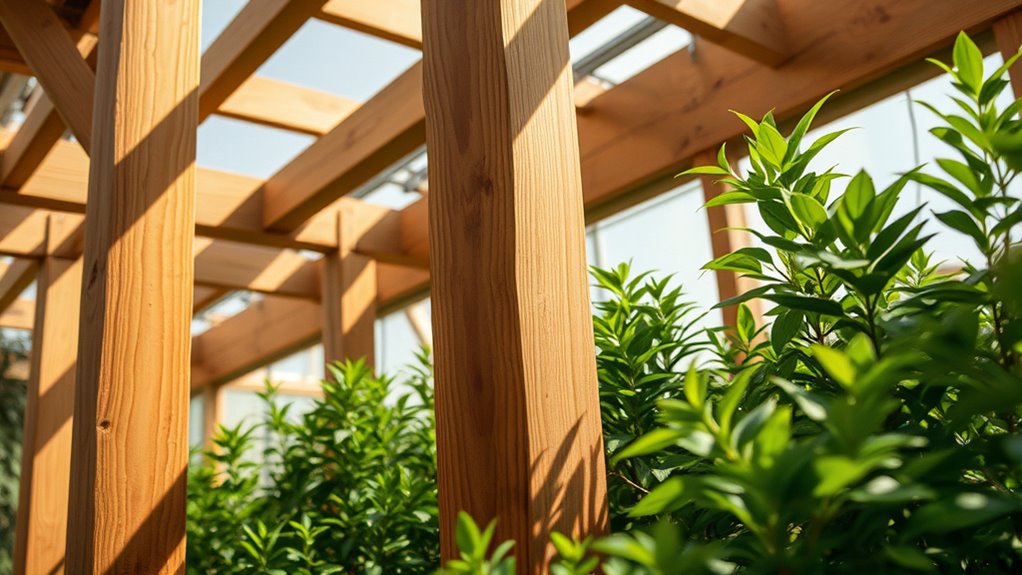
While many traditional building materials pose environmental challenges, engineered lumber emerges as a sustainable alternative that combines structural integrity with eco-friendly benefits.
By reducing carbon emissions and storing carbon throughout its lifecycle, engineered wood significantly lowers the environmental impact of construction. Its production process is energy-efficient, generating fewer emissions than steel or concrete.
With options like cross-laminated timber and glue-laminated timber, you’ll find engineered products provide excellent structural performance and flexibility, making them suitable for larger buildings.
Additionally, using small-dimension lumber maximizes resource efficiency, minimizing waste. Embracing engineered lumber can help you achieve green building certifications, promoting sustainable practices in your greenhouse construction while ensuring durability and strength in your design.
Sustainable Insulation Materials

Engineered lumber sets a strong foundation for sustainable greenhouse construction, but choosing the right insulation materials is just as vital for maintaining energy efficiency.
Consider cork insulation, which not only resists moisture but also offers antimicrobial and fire-resistant properties with an impressive R-value of 3.6 to 4.2 per inch.
Alternatively, cellulose insulation, made from recycled paper, supports a circular economy with an R-value of 3.5 to 3.8.
Sheep’s wool provides natural air purification while denim insulation, composed of 80% recycled material, offers 3.2 to 3.7 R-value.
Advanced aerogel insulation boasts high thermal performance.
Natural Heating and Cooling Methods

To maintain a comfortable environment in your greenhouse, employing natural heating and cooling methods can significantly enhance energy efficiency.
You can utilize passive solar heating by incorporating thermal mass materials like water barrels or stone, allowing them to absorb heat during the day and release it at night. Composting heat from organic materials or using simple candle pot heaters are also effective options.
For cooling, ensure proper cross-ventilation and consider shading techniques to prevent overheating. Integrating green roofs can provide insulation and cooling benefits as well.
Water Conservation Techniques
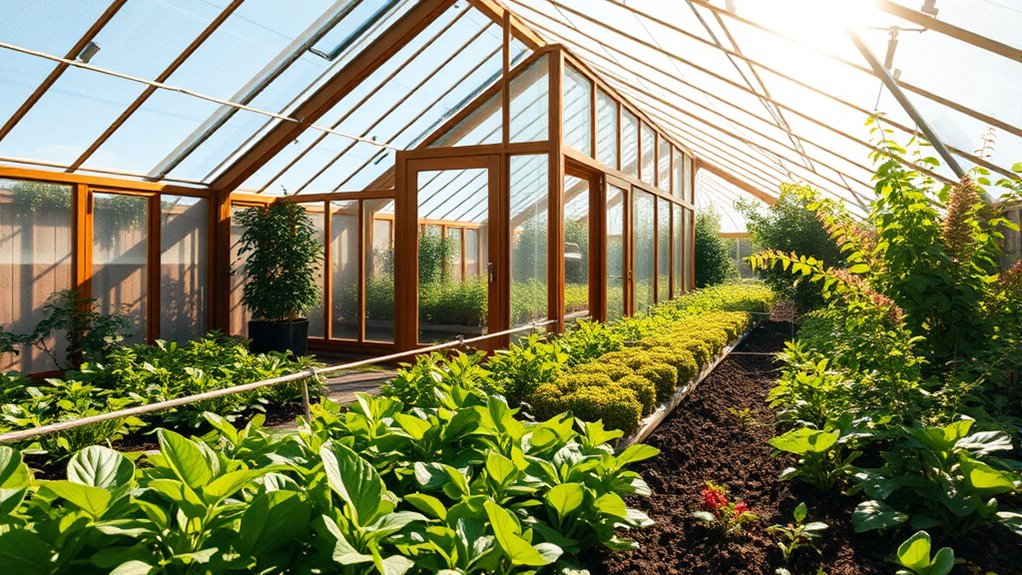
When you prioritize water conservation techniques in your greenhouse, you not only optimize resource use but also promote sustainability.
Implementing drip irrigation systems delivers water directly to plant roots, minimizing evaporation and maximizing efficiency.
Consider rainwater harvesting to capture and utilize natural rainfall, reducing your reliance on external sources.
Soil moisture sensors help you adjust irrigation precisely, ensuring plants get just what they need.
You might also explore grey water recycling, which can supplement irrigation when managed carefully.
Don’t forget about mulching; it retains soil moisture and supports healthy growth.
Renewable Energy Solutions
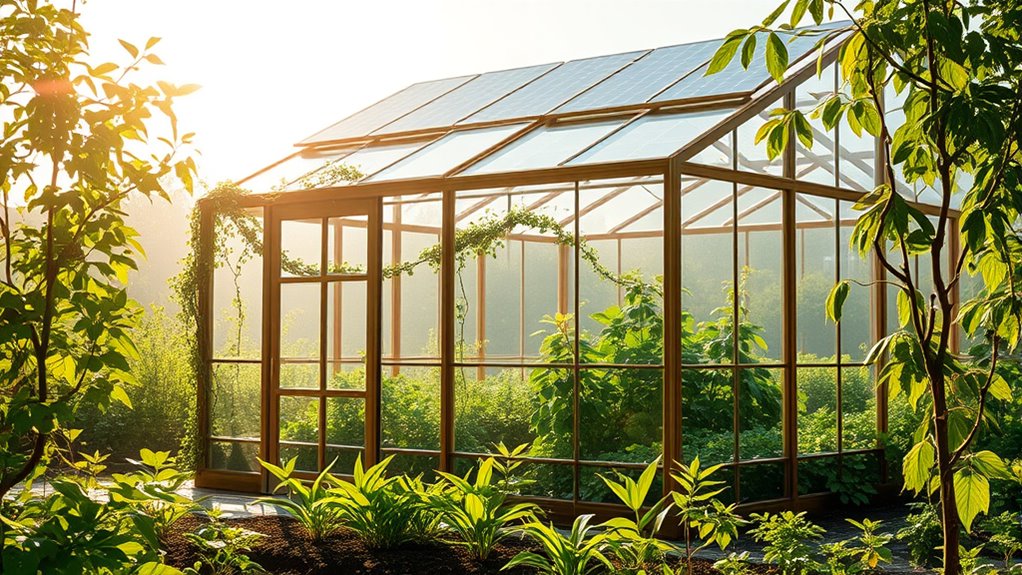
As greenhouse owners seek sustainable practices, incorporating renewable energy solutions can significantly enhance both efficiency and productivity.
Installing solar panels on your greenhouse roof makes the most of sunny days, while wind turbines can harness breezy conditions for electricity.
Biomass systems transform organic waste into energy, providing a sustainable heating source.
Solar thermal systems convert a high percentage of solar energy into heat, perfect for keeping your plants warm.
To further optimize energy use, consider LED lighting and thermal screens that reduce heating and cooling demands.
Implementing geothermal systems or heat pumps can also improve energy efficiency.
Sustainable Maintenance Practices

Implementing sustainable maintenance practices not only enhances the longevity of your greenhouse but also reduces its environmental impact.
Start by using reclaimed wood or recycled plastic for repairs, ensuring you minimize new material demand. Consider bamboo frameworks for their strength and sustainability. For insulation, opt for tempered glass or low-emissivity alternatives.
Utilize reclaimed materials and bamboo for repairs and insulation to enhance sustainability in your greenhouse.
Incorporate water conservation techniques like rainwater harvesting and drip irrigation to optimize water usage. Composting plant waste and repurposing containers can help manage waste effectively.
Regular soil testing and organic fertilizers maintain soil health, while crop rotation and companion planting promote biodiversity. Additionally, integrating sustainable practices into your greenhouse routine can significantly improve its overall efficiency.
Lastly, utilize natural ventilation and passive solar design to regulate climate efficiently. Each practice contributes to a greener, more efficient greenhouse.
Frequently Asked Questions
What Are the Benefits of Using Bamboo for Greenhouse Structures?
When you choose bamboo for greenhouse structures, you benefit from its rapid renewability and strength.
It grows quickly, reaching maturity in just a few years, and it’s lightweight, making transport easy.
Bamboo’s natural resistance to pests reduces the need for chemicals, keeping your environment healthier.
Plus, its flexibility allows for creative designs, while its aesthetic appeal enhances the overall look.
You’ll appreciate its durability and low maintenance, making it a smart choice for your greenhouse.
How Does Reclaimed Wood Affect Greenhouse Aesthetics?
Reclaimed wood adds a unique charm to your greenhouse, giving it a rustic and historical touch.
You’ll appreciate the distinct textures and colors that allow for extensive customization in your design. This material tells an environmental story, showcasing sustainability and resourcefulness.
Plus, the visual interest created by varied patterns can enhance your greenhouse’s overall aesthetic, making it not just functional but also a beautiful addition to your garden space.
Can Recycled Plastic Panels Be Repaired if Damaged?
Did you know that repairing materials can reduce waste by up to 70%?
Yes, you can repair recycled plastic panels if they get damaged. Common issues like cracks and UV degradation can often be fixed with specialized sealants or by replacing sections.
This approach not only saves money but also supports sustainability.
What Is the Lifespan of Engineered Lumber in Greenhouses?
The lifespan of engineered lumber in greenhouses typically ranges from 20 to 50 years, depending on maintenance and environmental conditions.
If you keep up with regular inspections and address any moisture or pest issues, you can significantly extend its longevity.
Engineered wood products, like CLT and glulam, are designed for durability and can withstand harsh conditions, making them a reliable choice for your greenhouse project.
How Do Solar Panels Impact Greenhouse Energy Costs?
Imagine your greenhouse as a sun-soaked oasis, where solar panels dance in the light.
By harnessing the sun’s energy, you’ll significantly cut your energy costs. Those panels work tirelessly, powering your systems and requiring little maintenance.
You’ll notice lower utility bills, freeing up funds for other investments. Plus, as you save money, you’ll boost your crop yields, turning your greenhouse into a flourishing paradise that thrives sustainably.
Conclusion
By choosing eco-friendly materials for your greenhouse, you not only reduce your environmental impact but also create a sustainable space for your plants. Did you know that using reclaimed wood can save up to 70% of the energy needed to produce new materials? Embracing options like recycled plastic panels and bamboo frameworks can enhance your greenhouse’s efficiency while fostering a healthier environment. With these choices, you’re investing in a greener future for both your garden and the planet.



